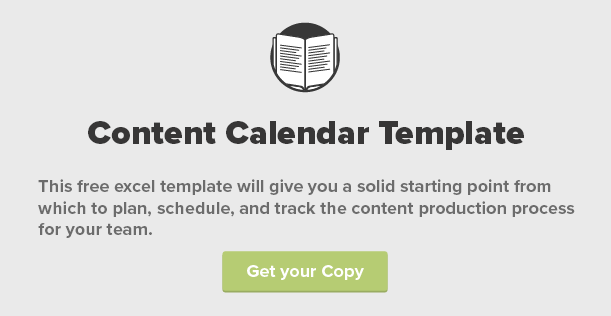Managing a content calendar can often feel like you’re juggling ketchup popsicles on a hot day while wearing white gloves.
Are you producing the right volume of content every day, week, and month? Are you addressing your audience’s needs? Are you hitting all of the right SEO topics? One false move, and things could get messy.
That’s why we’ve decided to share our Content Calendar Template with you! This excel template will give you a solid starting point from which to plan, schedule, and track the content production process for your team.
Get your free copy of our Content Calendar Template now:
11 elements your content calendar should address:
We’ve revised and reworked our content calendar to create this successful template. While this approach has worked well for us, feel free to delete or add in aspects that you think should be kept track of for your brand. We’ll go through each section of the template and explain how to use it and why it’s important.
Launch date
Know when your content will be published by writing down the launch date up front. If you have many different contributors, you may want to add another column to track when drafts are due. This way you don’t get stuck rushing through last minute edits to publish content on time.
Content type
Keep all of your upcoming content listed in this one calendar to make it easier for you and your team to prioritize tasks and manage time efficiently. To help differentiate between different forms of content, use this section to label the content type. Content types can include things like: blog, report, template, guest post, cheat sheet, etc. Make sure to use consistent labels so you can easily sort your content by type in excel.
Title
Your planned title doesn’t have to be the final title for that piece of content. Just make sure it’s descriptive enough to provide guidance on the topic being addressed. If you want to provide more details about the piece, leave them in the “notes” section at the end.
Question being answered
Creating content for your audience is about providing value for your readers. What question does your audience have that you’re looking to answer in your content? Identify this question to clarify whether or not the information is valuable and addresses a specific need.. If you can’t identify a compelling question, then ditch the idea.
Category
The category section is meant to help you create buckets for the topics your brand’s content addresses. By categorizing your content, you can easily tell whether or not you are hitting all of the topics you need to in your content calendar. You can also create a cadence for your content, so you can spread out pieces on the same topic and provide a well-rounded content offering to your audience.
Audience
Audience can also be described as a buyer persona. Essentially, you want to identify who your target audience is for that piece of content. You also want to make sure that you are creating targeted content for all of your brand’s different buyer personas.
Goals
Know the purpose of your content. That purpose can be to increase newsletter subscriptions, drive report downloads, or improve traffic to your brand’s blog. Make sure your goal is measurable, and specifically name the metric used to measure success.
Keyword
Creating a keyword strategy for your content is an endeavor in and of itself. However, earmarking certain keywords for future content helps you execute on your SEO strategy. Rather than spending time reworking keywords for different pieces of content you’ve already published, plan their use out in advance and keep track of them so you know which ones you’ve already used when planning future content.
Content lead
Every piece of content should have an assigned lead from your team. This is someone who is managing the production process and is responsible for having a quality content product ready to launch by the scheduled date. Note any additional contributors after the lead, so you know who the content lead is working with on that particular piece of content.
Status
Status describes the production stage for a piece of content. These can include things like: complete, draft, hold, etc. Use consistent descriptions so your team knows exactly what each status means. You can even color code each status to help items at certain stages in the production process to stick out. For example, we use green for “complete” and yellow for “draft.”
Notes
Need to add more details about a piece of content? Put those right here in the notes section, so you won’t forget them.
When executing your content calendar, remember…
Content is only one part of your team’s marketing calendar. It should compliment and align with scheduled activities, including demand generation, events, design, and other important aspects of your brand’s marketing strategy.
Be prepared to not only revise your content calendar based on leading metrics, but also to be flexible when it’s necessary to adjust launch dates. Always have a backup plan, or even better, backup content lined up should you need to reschedule items.
Ready to start improving your content planning process? Download your free copy of our Content Calendar Template now!


